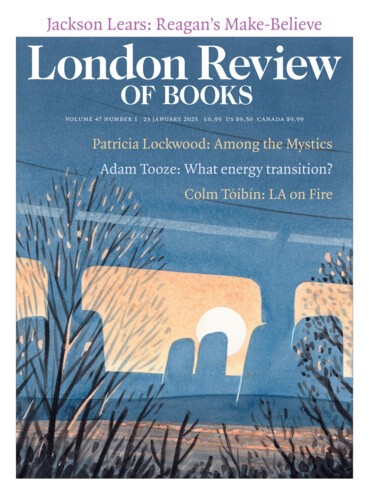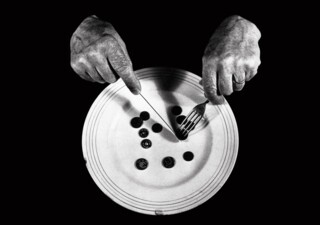Peter Kennard is an expert in the obvious. His art – if that is the word – seems all polemic and assertion, with little in the way of ambiguity, connotation or aesthetic import. Photomontage, which has been his primary form for more than fifty years, is always in focus, its borrowed elements (however grainy, stark or blurred) arrayed on the same legible plane, all to the point and on the nose. Kennard, who trained as a painter at the Byam Shaw and Slade art schools in the 1960s, rejected both the gallery system and the theoretical turn among his generation – though he shares something with 1970s conceptualism when he says that he thinks of his montages as sentences. The impression is that each work says one thing and one only. John Berger wrote of Kennard: ‘I would say his work was pure – if the word hadn’t become dirty.’
Archive of Dissent, an exhibition at the Whitechapel Gallery (until 19 January), complicates the idea of Kennard’s work as univocal and determined. As a student, he was politicised by protests against the Vietnam War. An early poster featured a blown-up detail from a John Filo photograph of the body of Jeffrey Miller, shot dead by the National Guard at Kent State University in May 1970, with a pool of blood in the foreground. Kennard’s dyeline print bled red ink in the rain. He soon became a regular contributor to radical papers and magazines; the exhibition includes pages from the New Statesman, Socialist Challenge and Workers’ Press. Kennard was responsible for well-known imagery attached to campaigns against America’s wars, nuclear weapons and apartheid as well as for workers’ rights and unions. Among his most reproduced images: John Constable’s Hay Wain laden with cruise missiles; a skeleton reading the notorious apocalypse-preparedness leaflet Protect and Survive; and, on the cover of the New Statesman in 1979, Henry Kissinger with an American flag and a crying, injured child in place of spectacle lenses, bombs falling in front of his face. He depicted Margaret Thatcher as Queen Victoria: in one version, the fan in her hand becomes a Pershing missile.
In the mid-1980s, Kennard made a series of posters for the Greater London Council, then in its final days as a socialist hold-out against Thatcherism. ‘Keep London out of the killing ground,’ one demands, above a huddle of landmarks in a world bristling with missiles. Bristling missiles are one of Kennard’s motifs; variously resembling a nest of knives or sprouting crystals, the warheads protrude from a gas mask worn by the Earth or lurk inside the half-opened dome of a nuclear reactor. Some of Kennard’s most mordant images from this period proved depressingly apt decades later. In 1982, his skeleton in mortarboard and gown accompanied a Guardian article about funding cuts to universities; in 2020, now a professor at the Royal College of Art, Kennard made a print from the same image to help the hardship fund of the University and College Union. At the Whitechapel, visitors can flick through large, board-mounted versions of these works, as if at a freshers’ week poster sale.
These images are not without style. In the 1980s and early 1990s, you could think of Kennard as part of a renewed wave of graphic art and satire in Britain alongside Gerald Scarfe and the makers of Spitting Image. But Kennard’s motivations and context were quite different. In some ways his montages, schooled on the radical European monteurs of the 1920s and 1930s, suited not only small-scale left-wing publications but also the pages of the 1980s fashion and music press, where designers such as Neville Brody had instituted a whimsical version of Russian Constructivism. It was both fitting and alarming to open a copy of the NME in 1981 and find, opposite reviews of Echo and the Bunnymen and the Cure, a full-page Kennard skeleton with a mushroom cloud for a skull.
Some of Kennard’s photomontages directly invoke avant-garde precursors such as John Heartfield, Hannah Höch, Alexander Rodchenko or Bertolt Brecht’s War Primer. A pair of hands with knife and fork, poised above a plate sparsely scattered with small change, is a Thatcher-era variation on Heartfield’s Hurrah, the Butter is Gone! (1935): a family glutting themselves at a dinner table laden with machinery, tools and weapons. So far so direct – but Kennard can also come close to the more oblique or Surrealist montage of an artist such as Dora Maar. Isolation Cell (1974) shows a figure suffering, possibly strapped, on a bare cot, while in the foreground there looms a huge hand – mechanical, organic, allegorical or hallucinated? Isolation Cell has the obscure, nightmarish atmosphere of Maar’s Le Simulateur (1935), in which a small boy is shown arched in what might be agony or demonic possession inside a dark vaulted space.
In other words, a Gothic strain runs through Kennard’s seemingly direct, even agitprop art. A montage made to illustrate an article on jury trials strays into dream territory: the judge is faceless and the jury members have huge naked brains for heads. Along with an actual politics, it’s this strangeness that separates Kennard from the likes of Banksy, to whom he is sometimes lazily compared. The nearest he came was in 2005, in a collaboration with Cat Phillipps: Photo Op shows Tony Blair (shirtsleeves and lunatic grin) taking a selfie against the backdrop of a burning oil field. Banksy approved and included the image in an Oxford Street installation; a poster version is now in the collection of the National Portrait Gallery.
Photo Op lives mostly online, where it is resurrected, usually without credit, each time Blair gnashes his way back into public view. It’s the work of Kennard’s that most starkly puts the question: can the art of political photomontage continue to function as print declines and memes both crude and ingenious proliferate? Kennard was aware of the problem in the 1990s, when he began to turn towards gallery installation as an alternative medium. Archive of Dissent includes a number of these works: newspaper pages showing atrocities or economic statistics, arrayed in grids and faintly or intermittently illuminated. They introduce a degree of mystery, and duration, that is quite at odds with the Augenblick assault of Kennard’s montage proper. One can see how the shift to the gallery and to installation promised an afterlife for photomontage, but it now seems like a retreat: not so much into aesthetics as into a false idea of presence and interaction.
The most urgent, contemporary-seeming work in Archive of Dissent is the simplest. Certain graphic and print media for political speech and image-making may have declined in recent decades, but we can hardly say we live in a world without placards, which have unexpectedly adapted to become walking memes, embodied instances of irony, sincerity, visual and rhetorical force, on the street or the screen. Kennard knows this, and at the Whitechapel includes a small forest of placards behind police tape. Stripped of their textual legends, Kennard’s images remain precise and perfectly obvious: a Palestinian flag imprisoned in a death’s-head hourglass, the words ‘never again’ being erased from a blackboard, a rain of bombs turning into grain sacks.
Send Letters To:
The Editor
London Review of Books,
28 Little Russell Street
London, WC1A 2HN
letters@lrb.co.uk
Please include name, address, and a telephone number.


